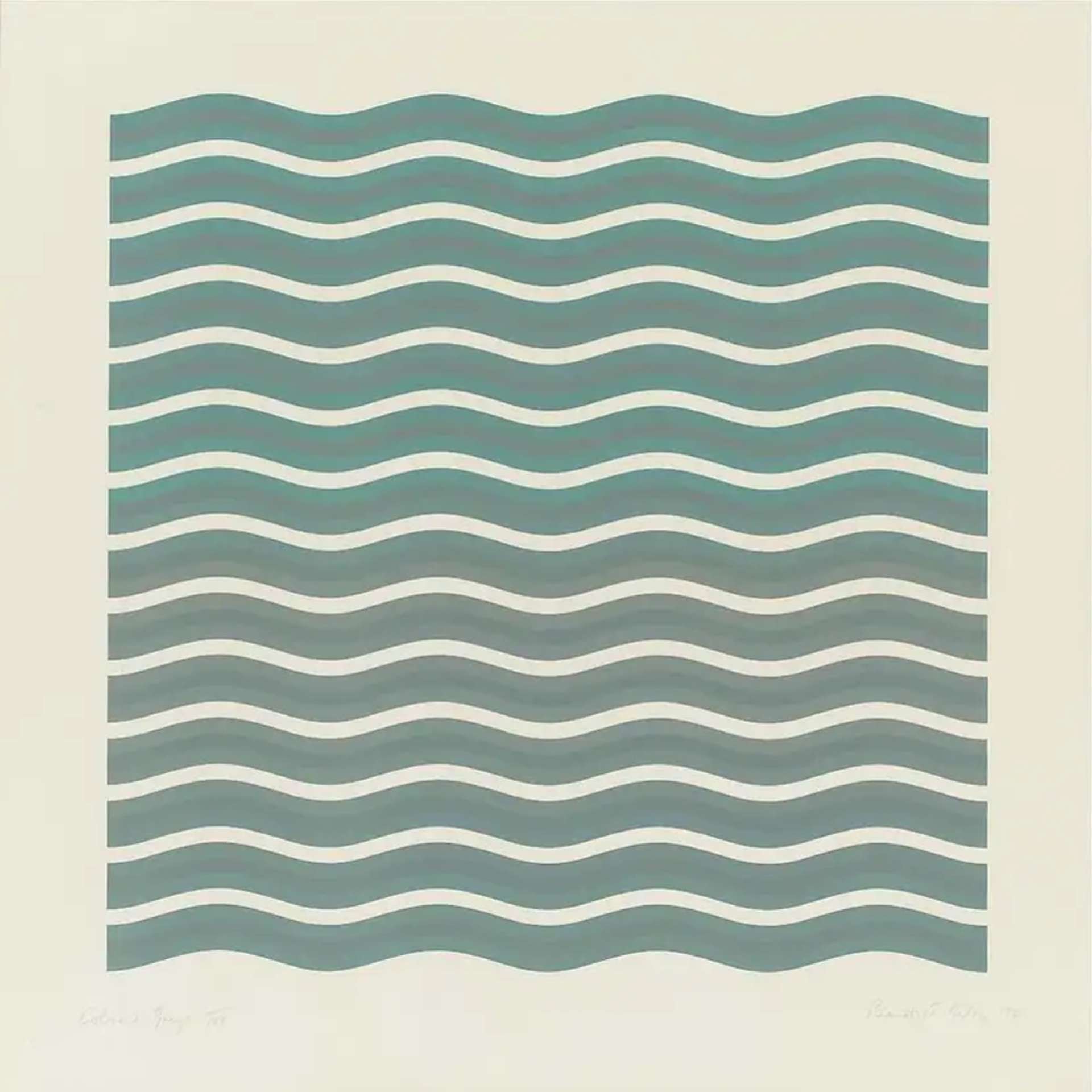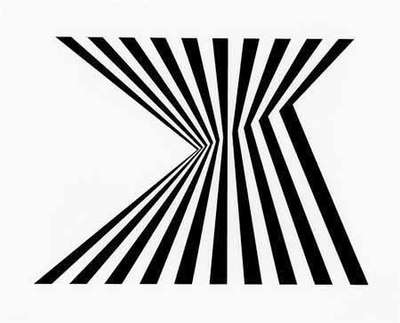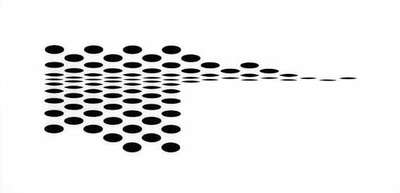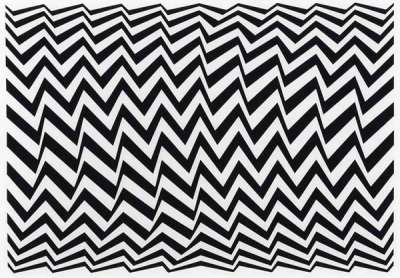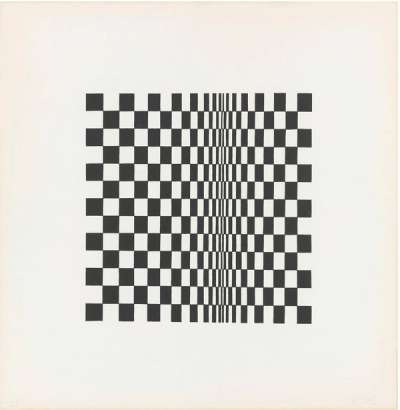 Untitled (Based On Movement In Squares) © Bridget Riley 1962
Untitled (Based On Movement In Squares) © Bridget Riley 1962
Bridget Riley
106 works
Bridget Riley's Movement In Squares stands as a testament to her groundbreaking exploration into the realm of optical illusions, marking a pivotal moment in the Op Art movement of the 1960s. This piece, a mesmerising composition of black and white squares that appear to pulsate and shift before the viewer's eyes, encapsulates Riley's deep dive into visual perception. Riley has revolutionised the art world with her innovative use of geometric patterns and contrasts, challenging viewers to experience art beyond the surface.
Who Is Bridget Riley?
Bridget Riley, born in 1931 in London, is a distinguished British artist renowned for her pivotal role in the development of the Optical Art (Op Art) movement during the 1960s. Her work is characterised by its innovative use of geometric shapes, vibrant colours, and intricate patterns to create optical illusions that provoke a dynamic visual experience. Riley's art is not merely about what is seen on the surface but engages deeply with the viewer's perception, challenging the way we interpret and understand visual stimuli.
Riley's style evolved from her early work, which was influenced by Pointillism and Impressionism, towards the distinctive Op Art for which she is best known. She gained international acclaim with her black-and-white works that explore the interaction of shape and form, light and darkness, creating sensations of movement and colour within strictly monochrome compositions. Over time, Riley introduced colour into her work, masterfully using it to enhance the vibrancy and energy of her optical effects.
Riley's significance in the art world extends beyond her contributions to Op Art. She is celebrated for her rigorous approach to the study of perception and her ability to translate complex visual experiences into compelling artworks. Her influence is evident in a wide range of fields, including design, fashion, and architecture, where her explorations of visual dynamics continue to inspire new generations of artists and designers.
Throughout her career, Riley has received numerous accolades, including the International Prize for Painting at the Venice Biennale in 1968. Her work is held in major public collections worldwide, and she remains an influential figure in contemporary art, continuously exploring new avenues of visual expression and perception. Riley's enduring fascination with the complexities of seeing and her commitment to visual experimentation make her a seminal figure in the landscape of 20th and 21st-century art.
The Birth of Movement in Squares
Riley’s Movement In Squares, created in 1961, marks a pivotal moment in the development of Op Art and encapsulates Riley's exploration into visual perception and the dynamic interplay of form and illusion. This piece is a seminal work in Riley's career and in the broader context of optical art, showcasing her innovative approach to creating visual experiences.
Riley's journey into Op Art began with her deep interest in the nature of visual perception and the ways in which the eye processes and interprets patterns and movements. Inspired by the works of artists such as Victor Vasarely, the father of Op Art, and the Constructivists, who emphasised the material and spatial aspects of art, Riley began experimenting with geometric shapes and contrasting colours to explore the instability of the visual experience.
The inspiration behind this and much of Riley's early work can also be traced to her study of nature and her interest in the dynamic patterns found in the natural world. Riley sought to capture the essence of movement and rhythm inherent in nature, translating these qualities into a purely abstract form. This piece, in particular, reflects her fascination with the idea of creating a sense of motion and depth on a flat surface, inviting viewers to experience the artwork in a way that is both physically engaging and psychologically stimulating.
Riley's Movement In Squares represents a confluence of scientific inquiry, artistic experimentation, and a deep-seated curiosity about the mechanics of vision. It stands as a testament to her innovative approach to art-making, her ability to transcend traditional boundaries of form and content, and her significant contribution to the Op Art movement and the broader discourse on visual perception in art.
An Analysis of Movement In Squares
Composition
The composition of Movement In Squares is deceptively simple, yet it embodies a complex understanding of visual perception. The work consists of a sequence of squares arranged in a grid that stretches vertically. The squares maintain a uniform size at the top of the canvas, but as the viewer's eye moves downwards, they begin to distort, stretching and compressing to create a dramatic sense of depth and movement. This manipulation of shape tricks the eye into seeing a three-dimensional form emerging from a flat surface, engaging the viewer in a visual dialogue with the artwork.
Use of Colour
Unlike many of her later works from her Lozenges and Stripes series, Movement In Squares is executed entirely in black and white. This absence of colour focuses the viewer's attention on the interplay of shape and space. By limiting her palette, Riley amplifies the visual tension between the geometric forms, highlighting the artwork's structural rhythm. The stark contrast between black and white enhances the optical effects, making the distortions more pronounced and the sense of movement more compelling.
Optical Illusions
The optical illusion is a result of Riley's arrangement of the squares. The artwork exploits the human eye's tendency to fill in gaps and create continuity where there is none, leading to the perception of motion. As the squares deform, they suggest a surface that bends and folds, challenging the viewer's understanding of space and perspective. This illusion of depth and movement is purely a construct of the viewer's mind, prompted by the visual cues Riley provides.
This work is emblematic of Riley's broader inquiry into the science of seeing and the ways in which visual perception can be engaged and manipulated through art. Movement In Squares not only showcases Riley's mastery over form and illusion but also reflects her interest in the psychological effects of visual stimuli. By reducing her visual language to simple geometric shapes and a monochrome palette, Riley achieves a complexity of experience that belies the work's apparent simplicity.
The Reception and Legacy of Movement In Squares
The critical reception of Riley's Movement In Squares has been overwhelmingly positive since its creation in 1961, marking it as a seminal work in the development of Op Art and establishing Riley as a leading figure in this movement. The artwork's innovative use of geometric abstraction to elicit optical illusions captivated both the public and critics, aligning it with a moment in art history where visual experience became a form of exploration and engagement.
Upon its debut, it was praised for its pioneering approach to visual perception. Critics and viewers alike were fascinated by how Riley's precise manipulation of simple geometric shapes could generate such a profound illusion of depth and movement. Its legacy however, extends far beyond its initial reception. Movement In Squares has played a crucial role in shaping the discourse around optical art and has influenced subsequent generations of artists interested in visual perception and the dynamic between viewer and artwork. Riley's method of engaging the viewer's sensory experience has informed not only visual arts but also design, architecture, and fashion, illustrating the broad applicability of her insights into visual perception.
Collecting Bridget Riley with MyArtBroker
MAB100: Navigating the Art Print Investment Landscape
MyArtBroker introduces the MAB100, a pioneering index that curates a list of the top 100 artists, offering a strategic guide for investors interested in the vibrant art print market. This index is the result of an advanced algorithm tailored to monitor and analyse the liquidity and market stature of art prints, with a special focus on influential artists like Bridget Riley.
By evaluating artworks based on cumulative investment, MAB100 ensures that investors are presented with a portfolio that not only mirrors current market valuations but also hints at future appreciation potential. This index stands out by not just tracking market trends but by forecasting future movements, providing a robust tool for investors. With MAB100, MyArtBroker has democratised access to in-depth market analyses and price discovery, traditionally reserved for auction houses, thus simplifying the investment journey for art collectors globally.
MyPortfolio: A Revolutionary Tool for Bridget Riley Collectors
MyPortfolio by MyArtBroker emerged as a groundbreaking platform, specifically enhancing the collection management of Bridget Riley prints, including iconic pieces like Movement In Squares. This platform transforms the art investment landscape by offering a suite of tools that allow collectors to track the valuation of their Riley prints over time, similar to managing a financial portfolio but designed exclusively for the nuances of the art market. This innovative approach provides both enthusiasts and seasoned investors with the insights needed to navigate the acquisition and sale of Riley's work, ensuring that every decision is informed and strategic. MyPortfolio embodies the future of art collection management, making it an indispensable resource for those looking to deepen their engagement with the market.
Bridget Riley's Impact on Contemporary Art
Riley's contributions to the field of visual art, epitomised by her seminal work Movement In Squares, have had a profound and lasting impact on contemporary art and artists. Her exploration of optical effects and perception has transcended the Op Art movement, influencing a broad spectrum of art practices and movements. Riley's work has not only paved the way for a deeper understanding of visual perception in art but has also inspired artists across various disciplines to explore and incorporate optical and kinetic effects into their work.
Contemporary artists have drawn inspiration from Riley's methodical approach to creating engaging and dynamic visual experiences. Her ability to manipulate simple geometric forms to produce complex visual effects has encouraged artists to experiment with the optical potentials of their mediums. Riley's influence is evident in the way these artists engage the viewer's sensory experience, creating immersive environments that challenge and expand the viewer's perception of space and form.
Through her pioneering endeavors, Bridget Riley has not only reshaped the contours of visual art but has also embedded a legacy that continues to ripple through the art world, inspiring a continuum of innovation and exploration in how we perceive and engage with art.





